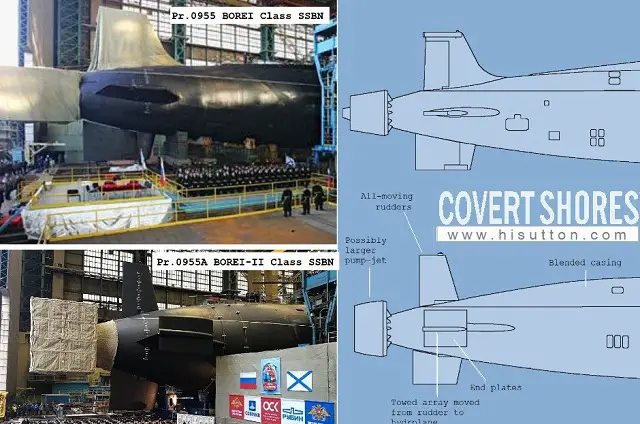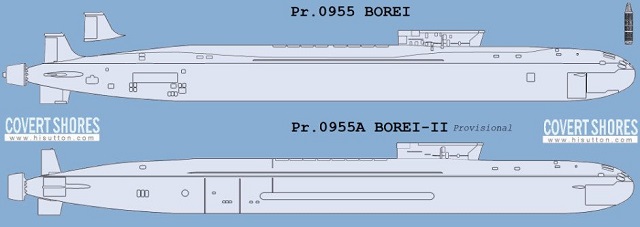Breaking news
Analysis: Russia's Project 955A SSBN Design Improvements over Project 955.
| 2017
|
|
|||
 One of the main difference between the new Project 955A and the previous 955 variant: All moving rudders and vertical endplates added to the hydroplanes (with towed array in it). Picture via Covert Shores. One of the main difference between the new Project 955A and the previous 955 variant: All moving rudders and vertical endplates added to the hydroplanes (with towed array in it). Picture via Covert Shores. |
|||
|
|
|||
|
Complex design determined three main modernization guidelines for initial project 955 submarines. They include decreased noisiness, higher maneuverability, and auxiliary systems in charge of detecting the adversary and engaging weapons.
The difficult task of the creation of the underwater fleet is always compared with major city operations, which need a single mechanism and thousands of auxiliary tools to manage. An overwhelming majority of technologies to build submarines is secret - from the design of the propeller screw to the ventilation system. It is only known that the upgraded submarine will be less noisy than its predecessors. It is to be noted that several research institutes were engaged in the design of noise insulation. The sound-adsorbing coating together with specifically located onboard equipment provides for practically noiseless combat patrol. The sound-absorbing insulation composition changes with the emergence of each submarine, as well as the method to fix it to the hull. Unique technologies for the creation of high-density substances decreased the noisiness of modern submarines over 100 times against Cold War era U-boats. |
|||
|
|
|||
 Project 955A received a pair of flank sonar arrays. Picture via Covert Shores. Project 955A received a pair of flank sonar arrays. Picture via Covert Shores. |
|||
|
|
|||
|
Speed and ability to escape from the adversary were always considered the main combat criteria of nuclear submarines. The Rubin designers focused on the ability of the new submarine to maneuver, change the depth and covertly move. Its power plant and propeller screws have a unique design, which allows the fourth-generation submarine to sail at a speed of nearly 30 knots underwater.
"It is necessary to observe technological procedures and provide minimum tolerance for the propeller screw to avoid cavitation, which considerably increases the noisiness of the U-boat and can also damage the product," expert Sergei Ivanov told Zvezda. Project 955A submarines have other innovations as well. They are equipped with hydraulic jets for covert movement, which together with high-duty low-magnetic hull allow sailing with maximum low noise at major depth and thus avoid detection by hydro-acoustic stations of the adversary. The main arms of project 955A submarine remained unchanged - the Bulava ballistic missile with six multiple individually targeted reentry vehicles. Each boat carries up to 16 such missiles with a maximum range of 9300 km. Experts say the 955A project also upgraded the command system and safety of missiles onboard. Experienced engineers say the only aim of the upgrade is to decrease launch preparation time to the minimum. Although experts agree the Prince Vladimir is already superior in combat capabilities than US Ohio-class submarines, the naval component of the Russian nuclear deterrence can soon be upgraded and reinforced with modern submarines codenamed Borei-B, the Zvezda said. © Copyright 2017 TASS. All rights reserved. This material may not be published, broadcast, rewritten or redistributed. Navy Recognition comment: For more details, check out our updated article and pictures at this link.. |
|||


























